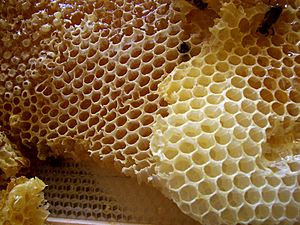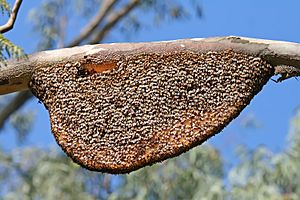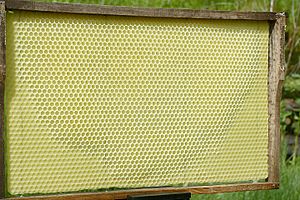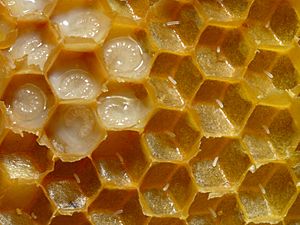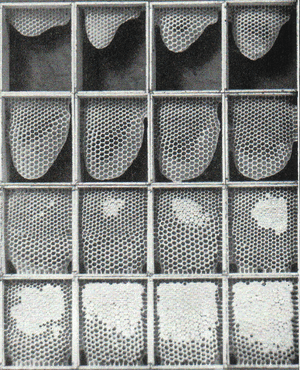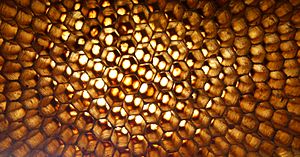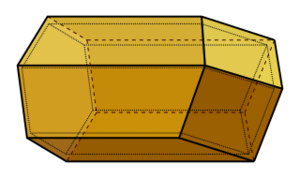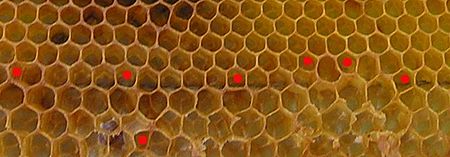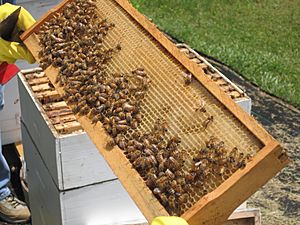Honeycomb facts for kids
A honeycomb is a special structure made by honey bees. It's built from wax and looks like a big sheet of tiny, six-sided rooms. Bees use these rooms in their nests to store honey and pollen. They also use them to raise their baby bees, called larvae.
Beekeepers, who look after bees, sometimes take out whole honeycombs to collect the honey. Bees work hard to make wax. They eat about 8.4 pounds (3.8 kg) of honey to make just 1 pound (454 g) of wax! Because of this, beekeepers often return the wax to the hive after they've taken the honey.
They can get the honey out by spinning the comb in a special machine called a honey extractor. This leaves the wax comb mostly whole. If a honeycomb gets too old or damaged, the wax can be melted down and reused. Beekeepers can make new sheets of wax with a hexagonal pattern. These "foundation" sheets help bees build new combs more easily. The pattern also encourages bees to build smaller cells for worker bees, instead of larger cells for drone bees.
Sometimes, fresh, new honeycomb is sold with the honey still inside. This is called comb honey. It's often eaten by spreading it on bread, rather than using it for cooking.
Contents
Types of Honeycomb
Honeycomb changes color over time depending on what it's used for.
Broodcomb
The part of the comb where baby bees (brood) are raised is called broodcomb. This comb gets darker over time. This happens because of the cocoons left behind by the growing bees. Also, the constant movement of many bee feet makes the comb look stained. Beekeepers call this "travel stain."
Honey Storage Comb
Honeycomb used only for storing honey usually stays light-colored. Beekeepers sometimes use a special screen called a queen excluder. This keeps the queen bee from laying eggs in the honey storage areas. This way, the honey comb stays clean and light.
Wasp Combs
Did you know that some wasps also build combs? Instead of wax, they use paper! Some wasps even store honey in their paper nests. But usually, when we say "honeycomb," we are talking about the wax combs made by honey bees.
Why Honeycomb is Hexagonal
Have you ever wondered why honeycomb cells are always six-sided? This shape is very special and efficient!
Perfect Shape for Bees
There are two main reasons why hexagons are used:
- Less Material: A hexagonal shape uses the least amount of material (wax) to create many equal-sized cells. Imagine trying to make round or square cells that fit together perfectly without gaps. Hexagons fit together perfectly, like a puzzle. This saves the bees a lot of effort and wax. This idea is known as the honeycomb conjecture in geometry.
- Natural Process: Another idea is that the hexagonal shape simply happens naturally as bees build cells close together. It's a bit like how soap bubbles form hexagonal shapes when they are squished together.
The cells in a honeycomb are usually built slightly tilted upwards. They slope between 9 and 14 degrees towards the open end. This small tilt helps prevent the honey from dripping out.
Three-Dimensional Design
The closed ends of the honeycomb cells are also very clever. They are made of three flat surfaces that meet at a point. These surfaces are shaped like rhombuses. This three-dimensional shape is also very efficient. It helps to use the least amount of wax for the space it holds.
The three-dimensional geometry of a honeycomb cell.
The way the cells are shaped means that two layers of honeycomb can fit perfectly into each other. Each flat surface at the end of a cell is shared by a cell on the opposite side.
Opposing layers of honeycomb cells fit together.
Real-World Cells
While the hexagon is the ideal shape, real honeycomb cells are not always perfectly hexagonal. They can be slightly off by a few percent. When bees build cells between larger drone comb and smaller worker comb, or if they hit an obstacle, the shapes can become distorted. You might see irregular or even five-sided cells in these areas.
How Bees Build Comb
Bees use their antennae, mandibles (jaws), and legs to shape the wax when building comb. They also actively warm the wax while they work. The temperature of the wax during construction is usually between 33.6 and 37.6°C (about 92.5 to 99.7°F). This temperature is important for the wax to be soft enough to mold. The bees' own body temperature helps them control the wax temperature perfectly for building their amazing combs.
Images for kids
See also
 In Spanish: Panal para niños
In Spanish: Panal para niños


